Stretford: Difference between revisions
m ioe -> nhle, replaced: {{IoE|212970 → {{NHLE|1067873, {{IoE|212974 → {{NHLE|1067874, {{IoE|212976 → {{NHLE|1067875 |
No edit summary |
||
| Line 30: | Line 30: | ||
Until the 1820s one of Stretford's main cottage industries was the hand-weaving of cotton. There were reported at one time to have been 302 handlooms operating in Stretford, providing employment for 780 workers, but by 1826 only four were still in use, as the mechanised cotton mills of nearby Manchester replaced handlooms. As Manchester continued to grow, it offered a good and easily accessible market for Stretford's agricultural products, in particular rhubarb, once known locally as Stretford beef. By 1836 market gardening had become so extensive around Stretford that one writer described it as the "garden of Lancashire"; in 1845 more than 500 tons of vegetables were being produced for the Manchester market each week. Stretford also became well known for its pig market and the production of black puddings, leading to the village being given the nickname of Porkhampton. A local dish, known as Stretford goose, was made from pork stuffed with sage and onions. During the 1830s, between 800 and 1,000 pigs a week were being slaughtered for the Manchester market. | Until the 1820s one of Stretford's main cottage industries was the hand-weaving of cotton. There were reported at one time to have been 302 handlooms operating in Stretford, providing employment for 780 workers, but by 1826 only four were still in use, as the mechanised cotton mills of nearby Manchester replaced handlooms. As Manchester continued to grow, it offered a good and easily accessible market for Stretford's agricultural products, in particular rhubarb, once known locally as Stretford beef. By 1836 market gardening had become so extensive around Stretford that one writer described it as the "garden of Lancashire"; in 1845 more than 500 tons of vegetables were being produced for the Manchester market each week. Stretford also became well known for its pig market and the production of black puddings, leading to the village being given the nickname of Porkhampton. A local dish, known as Stretford goose, was made from pork stuffed with sage and onions. During the 1830s, between 800 and 1,000 pigs a week were being slaughtered for the Manchester market. | ||
Situated on the border with Manchester, Stretford became a fashionable place to live in the mid-19th century. Large recreation areas were established, such as the Royal Botanical Gardens, opened in 1831. The gardens were sited in Old Trafford on the advice of scientist John Dalton, because the prevailing southwesterly wind kept the area clear of the city's airborne pollution.<ref>{{citation |contribution=Archive of the Royal Botanical and Horticultural Society of Manchester and the Northern Counties |publisher=The Archives Hub |url=http://www.archiveshub.ac.uk/news/0503rbhs.html |accessdate=10 January 2008}}</ref> In 1857, the gardens hosted the Art Treasures Exhibition, the largest art exhibition ever held in the United Kingdom.<ref>{{citation |contribution=Manchester 1857, a City of Industry |publisher=Manchester Art Gallery |url=http://www.manchestergalleries.org/whats-on/art-treasures-in-detail/manchester-1857/ |accessdate=16 January 2008}}</ref> A purpose-built iron and glass building was constructed at a cost of £38,000 to house the 16,000 exhibits. The gardens were also chosen as a site for the Royal Jubilee Exhibition of 1887, celebrating Queen Victoria's 50-year reign. The exhibition ran for more than six months and was attended by more than 4.75 million visitors. The gardens were converted into an entertainment resort in 1907, and hosted the first speedway meeting in | Situated on the border with Manchester, Stretford became a fashionable place to live in the mid-19th century. Large recreation areas were established, such as the Royal Botanical Gardens, opened in 1831. The gardens were sited in Old Trafford on the advice of scientist John Dalton, because the prevailing southwesterly wind kept the area clear of the city's airborne pollution.<ref>{{citation |contribution=Archive of the Royal Botanical and Horticultural Society of Manchester and the Northern Counties |publisher=The Archives Hub |url=http://www.archiveshub.ac.uk/news/0503rbhs.html |accessdate=10 January 2008}}</ref> In 1857, the gardens hosted the Art Treasures Exhibition, the largest art exhibition ever held in the United Kingdom.<ref>{{citation |contribution=Manchester 1857, a City of Industry |publisher=Manchester Art Gallery |url=http://www.manchestergalleries.org/whats-on/art-treasures-in-detail/manchester-1857/ |accessdate=16 January 2008}}</ref> A purpose-built iron and glass building was constructed at a cost of £38,000 to house the 16,000 exhibits. The gardens were also chosen as a site for the Royal Jubilee Exhibition of 1887, celebrating Queen Victoria's 50-year reign. The exhibition ran for more than six months and was attended by more than 4.75 million visitors. The gardens were converted into an entertainment resort in 1907, and hosted the first speedway meeting in Manchester on 16 June 1928.<ref>{{citation |contribution=White City Track| publisher=UK Running Track Directory |url=http://www.runtrackdir.com/details.asp?track=manchester-wc |accessdate=9 January 2008}}</ref> There was also greyhound racing from 1930, and an athletics track. The complex was demolished in the late 1980s, and all that remains is the entrance gates, close to what is now the White City Retail Park. The gates were designated a Grade II listed structure in 1987.<ref>{{NHLE|1067874|Entrance Portal and Lodges to Former White City Greyhound Track}}</ref> | ||
===Industrialisation=== | ===Industrialisation=== | ||
Latest revision as of 10:37, 19 September 2019
| Stretford | |
| Lancashire | |
|---|---|
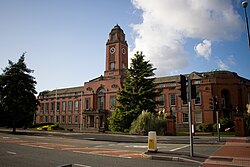 Trafford Town Hall in Stretford | |
| Location | |
| Grid reference: | SJ795945 |
| Location: | 53°26’48"N, 2°18’31"W |
| Data | |
| Population: | 37,455 (2001) |
| Post town: | Manchester |
| Postcode: | M32 |
| Dialling code: | 0161 |
| Local Government | |
| Council: | Trafford |
| Parliamentary constituency: |
Stretford and Urmston |
Stretford is a town in Lancashire, spread out on the plain between the River Mersey and the Manchester Ship Canal, four miles to the south-west of Manchester city centre, three miles south of Salford. Stretford is contiguous with the suburb of Chorlton-cum-Hardy to the east, and the towns of Urmston to the west, Salford to the north, and Sale to the south. The Bridgewater Canal bisects the town.
During much of the 19th century Stretford was an agricultural village known locally as Porkhampton, a reference to the large number of pigs produced for the nearby Manchester market. It was also an extensive market gardening area, producing more than 500 tons of vegetables each week for sale in Manchester by 1845. The arrival of the Manchester Ship Canal in 1894, and the subsequent development of the Trafford Park industrial estate in the north of the town, accelerated the industrialisation that had begun in the late 19th century. By 2001 less than 1% of Stretford's population was employed in agriculture.
Stretford has been the home of Manchester United Football Club since 1910, and of Lancashire County Cricket Club since 1864.
History
The name Stretford is Old English; stræt ford; “street ford”, on a ford across the River Mersey. The principal road through Stretford, the A56 Chester Road, follows the line of the old Roman road from ‘’Deva Victrix’’ (Chester) to ‘’Mancunium’’ (Manchester), crossing the Mersey into Stretford at Crossford Bridge, built at the location of the ancient ford.
By 1212, there were two manors in the area now called Stretford. The land in the south, close to the River Mersey, was held by Hamon de Mascy, while the land in the north, closer to the River Irwell, was held by Henry d Trafford. In about 1250, a later Hamon de Mascy gave the Stretford manor to his daughter, Margery. She in turn, in about 1260, granted Stretford to Richard de Trafford at a rent of one penny. The de Mascy family shortly afterwards released all rights to their lands in Stretford to Henry de Trafford, the Trafford family thus acquiring the whole of Stretford, since when the two manors descended together.
The de Trafford family leased out large parts of the land, much of it to tenants who farmed at subsistence levels. Although there is known to have been a papermill operating in 1765, the area remained largely rural until the early 20th-century development of Trafford Park in the Old Trafford district north of the town. Until then Stretford "remained in the background of daily life in England", except for a brief cameo role during the Jacobite rebellion of 1745, when Crossford Bridge was destroyed to prevent a crossing by Bonnie Prince Charlie's army during its abortive advance on London; the bridge was quickly rebuilt.
Until the 1820s one of Stretford's main cottage industries was the hand-weaving of cotton. There were reported at one time to have been 302 handlooms operating in Stretford, providing employment for 780 workers, but by 1826 only four were still in use, as the mechanised cotton mills of nearby Manchester replaced handlooms. As Manchester continued to grow, it offered a good and easily accessible market for Stretford's agricultural products, in particular rhubarb, once known locally as Stretford beef. By 1836 market gardening had become so extensive around Stretford that one writer described it as the "garden of Lancashire"; in 1845 more than 500 tons of vegetables were being produced for the Manchester market each week. Stretford also became well known for its pig market and the production of black puddings, leading to the village being given the nickname of Porkhampton. A local dish, known as Stretford goose, was made from pork stuffed with sage and onions. During the 1830s, between 800 and 1,000 pigs a week were being slaughtered for the Manchester market.
Situated on the border with Manchester, Stretford became a fashionable place to live in the mid-19th century. Large recreation areas were established, such as the Royal Botanical Gardens, opened in 1831. The gardens were sited in Old Trafford on the advice of scientist John Dalton, because the prevailing southwesterly wind kept the area clear of the city's airborne pollution.[1] In 1857, the gardens hosted the Art Treasures Exhibition, the largest art exhibition ever held in the United Kingdom.[2] A purpose-built iron and glass building was constructed at a cost of £38,000 to house the 16,000 exhibits. The gardens were also chosen as a site for the Royal Jubilee Exhibition of 1887, celebrating Queen Victoria's 50-year reign. The exhibition ran for more than six months and was attended by more than 4.75 million visitors. The gardens were converted into an entertainment resort in 1907, and hosted the first speedway meeting in Manchester on 16 June 1928.[3] There was also greyhound racing from 1930, and an athletics track. The complex was demolished in the late 1980s, and all that remains is the entrance gates, close to what is now the White City Retail Park. The gates were designated a Grade II listed structure in 1987.[4]
Industrialisation
The arrival of the Manchester Ship Canal in 1894, and the subsequent development of the Trafford Park industrial estate in the north of the town – the first planned industrial estate in the world – had a substantial effect on Stretford's growth. The population in 1891 was 21,751, but by 1901 it had increased by 40% to 30,436 as people were drawn to the town by the promise of work in the new industries at Trafford Park.[5]
During the Second World War Trafford Park was largely turned over to the production of matériel, including the Avro Manchester heavy bomber, and the Rolls-Royce Merlin engines used to power both the Spitfire and the Avro Lancaster. That resulted in Stretford being the target for heavy bombing, particularly during the Manchester Blitz of 1940. On the nights of 22/23 and 23/24 December 1940 alone, 124 incendiaries and 120 high-explosive bombs fell on the town, killing 73 people and injuring many more. Among the buildings damaged or destroyed during the war were Manchester United's Old Trafford football ground, All Saints' Church,[6] St Hilda's Church,[7] and the children's library in King Street.[8] Smoke generators were set up in the north of the town close to Trafford Park in an effort to hide it from enemy aircraft, and 11,900 children were evacuated to safer areas in Lancashire, Cheshire, Derbyshire, and Staffordshire, along with their teachers and supervisors. A memorial to those residents who lost their lives in the bombing was erected in Stretford Cemetery in 1948, over the communal grave of the 17 unidentified people who were killed in the blitz of December 1940.
Between 1972 and 1975, what is now the B&Q store in Great Stone Road was the 3,000-capacity Hardrock Theatre and Village Discothèque, hosting some of that period's major artists in their prime. Led Zeppelin, David Bowie, Bob Marley, Elton John, Hawkwind, Yes, Chaka Khan, Curved Air and Lou Reed were amongst those who appeared. Tangerine Dream was the last band to perform at the Hardrock, on 19 October 1975.[9] In more recent years, Lancashire Cricket Club's Old Trafford ground, next door, has provided a concert venue for bands such as Oasis, Foo Fighters, The Cure, Radiohead, Coldplay, Arctic Monkeys and Take That.
Transport history
Stretford's growth was fuelled by the transport revolutions of the 18th and especially the 19th century: the Bridgewater Canal reached Stretford in 1761, and the railway in 1849. The completion of the Manchester South Junction and Altrincham Railway (MSJAR) in 1849, passing through Stretford, led to the population of the town nearly doubling in a decade, increasing from 4,998 in 1851 to 8,757 by 1861.
Because Stretford is situated on the main A56 road between Chester and Manchester many travellers passed through the village, and as this traffic increased, more inns were built to provide travellers with stopping places. One of the earliest forms of public transport through Stretford was the stagecoach; the Angel Hotel, on the present day site of the Bass Drum public house,[10] was one of the main stopping places for stagecoaches in Stretford, and the Trafford Arms was another. The stagecoach service through Stretford is believed to have ended some time in the 1840s, about the time that horse-drawn omnibuses arrived, in 1845. The Manchester Carriage Company's tramway from Manchester to Stretford was built in 1879, terminating at the Old Cock Hotel on the A56 road, next to which a small depot was built to house the cars and horses. A 1900 timetable shows that trams left for Manchester every 10 minutes between 8:00 am and 10:15 pm. The horse-drawn trams were replaced with electric trams in 1902,[11] and after the Second World War the trams were replaced by buses.[12]
The MSJAR railway line through Stretford was electrified in 1931, and was converted to light rail operation in 1992, when it became part of the Manchester Metrolink tram network. The first Metrolink tram through Stretford ran on 15 June 1992.
About the town
The Great Stone
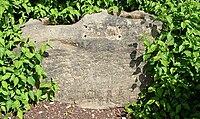
The Great Stone, which gave its name to the Great Stone Road, where it was located until being moved in 1925, is one of Stretford's most easily overlooked landmarks. The stone is composed of millstone grit and was probably deposited as a glacial erratic. It is rectangular in shape, about 5 feet wide, 2 feet deep, and 3 feet tall, with two 7-inch deep rectangular slots cut into its upper surface.
Several suggestions have been made for the history of the Great Stone. There was a succession of plagues in Manchester from the 14th century onwards,[13] and during the Great Plague of 1655–56 the holes in the top of the stone were filled with vinegar or holy water, through which coins were passed in the belief that would halt the spread of the disease.[14] But the holes are probably too deep for that to have been the stone's original purpose. It may have been a marker on the Roman road between Northwich and Manchester, or some kind of boundary marker.[15] The Great Stone is also thought to have been the base of an Anglo-Saxon cross shaft. A local legend had it that the stone was slowly sinking into the earth, and that its ultimate disappearance would mark the end of the world.
When the Great Stone Road was widened in the late 19th century, the stone was moved back from the road slightly. In 1925, the stone was moved again, to its current location outside the North Lodge of Gorse Hill Park, about 328 feet from its historical location. The stone is a Grade II listed structure.[16]
Cenotaph
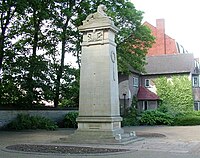
Stretford Cenotaph, opposite the Chester Road entrance to Gorse Hill Park, was built as a memorial to the 580 Stretford men who lost their lives in the First World War. It was formally unveiled in 1923, by the Earl of Derby, Secretary of State for War.
Longford Park
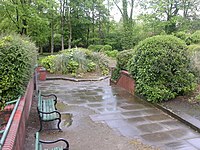
Longford Park is the largest park in the area, at 54 acres. It includes a pets' corner, botanical garden, bowling greens, children's play areas, and an athletics stadium, and is the finishing point of the annual Stretford Pageant.
Longford Park was the home of John Rylands, industrialist, philanthropist, and Manchester's first multi-millionaire, from 1855 until his death in 1888 and of his widow Enriqueta Augustina Rylands until her death in 1908. The house Rylands built in the park in 1857, Longford Hall, was demolished in 1995. It replaced an earlier house of the same name that had been the residence of Thomas Walker (died 1817) and subsequently of his sons Thomas (died 1836) and Charles. Today only the front porch, coach house, and the stable buildings remain.[17] The estate and hall were sold to Stretford Council in 1911 after a poll of ratepayers, and the park was opened to the public the following year.
Stretford Public Hall
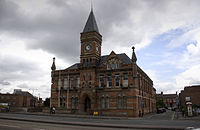
Stretford Public Hall was built in 1878 by John Rylands, designed by N Lofthouse. It stands on the western side of the A56 Chester Road, opposite the Longford Cinema. Stretford's first public lending library was established in the building in 1883. On the death of Rylands in 1888, his widow placed the building at the disposal of the local authority for a nominal rent, and on her own death in 1908, the building was bought by Stretford Council for £5,000.
Public baths were built to the rear of the building, accessed by way of Cyprus Street. In 1940 the new Stretford Library was opened on King Street, and the public hall was rendered surplus. The building re-opened in March 1949 as the Stretford Civic Theatre, with a well-equipped stage for the use of local groups. After the Stretford Leisure Centre opened in 1977 now Stretford Sports Village, the Cyprus Street Baths wing fell into disuse, and was demolished. The remainder of the building began to fall into disrepair, despite being designated a Grade II listed structure in 1987,[18] until the council refurbished and converted the hall to serve as council offices in the mid-1990s.
Trafford Town Hall
Trafford Town Hall stands in a large site at the junction of Talbot Road and Warwick Road, directly opposite the Old Trafford Cricket Ground. Work on the building, designed by architects Bradshaw Gass & Hope of Bolton, began on 21 August 1931.
The town hall officially came into use as Stretford Town Hall on the granting of Stretford's charter, on 16 September 1933. In 1974, on the formation of the new Trafford Metropolitan Borough, Stretford Town Hall was adopted as the base for the new council and renamed Trafford Town Hall; it was designated a Grade II listed building in 2007.
Union Church
The Union Church was formed in 1862, with John Rylands as its patron; he laid the foundation stone of its building in Edge Lane, close to Longford Park's southern entrance, in 1867. The church has since been converted into office accommodation.[19]
Outside links
| ("Wikimedia Commons" has material about Stretford) |
- Stretford Brass Band
- History of Stretford
- Edwin Waugh's journey to Stretford 1857
- Contemporary documentary on the Borough of Stretford, including footage of the 1933 Charter Day celebrations
- Saint Matthews Church Stretford
References
- ↑ "Archive of the Royal Botanical and Horticultural Society of Manchester and the Northern Counties", The Archives Hub, http://www.archiveshub.ac.uk/news/0503rbhs.html, retrieved 10 January 2008
- ↑ "Manchester 1857, a City of Industry", Manchester Art Gallery, http://www.manchestergalleries.org/whats-on/art-treasures-in-detail/manchester-1857/, retrieved 16 January 2008
- ↑ "White City Track", UK Running Track Directory, http://www.runtrackdir.com/details.asp?track=manchester-wc, retrieved 9 January 2008
- ↑ National Heritage List 1067874: Entrance Portal and Lodges to Former White City Greyhound Track
- ↑ "1901 Census of England and Wales", A Vision of Britain Through Time (Great Britain Historical GIS Project), http://www.visionofbritain.org.uk/census/table_page.jsp?tab_id=EW1901COU_M12&u_id=10075592&show=DB&min_c=1&max_c=5, retrieved 12 July 2007
- ↑ Trafford Lifetimes (Trafford Council), http://www.trafford.gov.uk/content/tca/display_image.asp?ImageID=2630, retrieved 2 August 2007
- ↑ "St. Hilda's church showing bomb damage", Trafford Lifetimes (Trafford Council), http://www.trafford.gov.uk/content/tca/display_image.asp?ImageID=2403, retrieved 2 August 2007
- ↑ "Bomb damage to the children's library, King Street", Trafford Lifetimes (Trafford Council), http://www.trafford.gov.uk/content/tca/display_image.asp?ImageID=5428, retrieved 2 August 2007
- ↑ Greenhalgh, Simon (3 August 2007), "Stretford's 'Hardrock' down memory lane", Messenger Newspapers, http://www.messengernewspapers.co.uk/features/traffordthroughtime/display.var.1594782.0.stretfords_hardrock_down_memory_lane.php, retrieved 8 December 2008
- ↑ "Bass Drum", Trafford Lifetimes (Trafford Metropolitan Borough Council), http://www.trafford.gov.uk/content/tca/display_image.asp?ImageID=3342, retrieved 11 July 2007
- ↑ "Historian reviews 1,000 years of town history", Sale and Altrincham Messenger, http://archive.thisistrafford.co.uk/2000/1/6/10109.html, retrieved 10 January 2008
- ↑ "A Short History of Road Passenger Transport in Greater Manchester", Greater Manchester's Museum of Transport, archived from the original on 12 December 2007, http://web.archive.org/web/20071212070014/http://www.gmts.co.uk/history/history.html, retrieved 10 January 2008
- ↑ The City and Parish of Manchester - A History of the County of Lancaster: Volume 4
- ↑ Nicholls, Curiosities of Greater Manchester, p. 86.
- ↑ National Monuments Record: No. 76747 – The Great Cross, Streford
- ↑ National Heritage List 1067875: The Great Stone Stretford
- ↑ "It was built in an indifferent Italianate style ... without any great pretensions."--Nikolaus Pevsner, in his Lancashire; 1: the industrial and commercial south, Penguin Books, 1969, p. 405
- ↑ National Heritage List 1067873: Stretford Civic Theatre
- ↑ "Stretford and the Rylands Legacy", Friends of Longford Park, http://friendsoflongfordpark.org.uk/?cat=11, retrieved 18 March 2009
- Bayliss, Don (1996), Historical Atlas of Trafford, Don Bayliss, ISBN 0-9529300-0-5
- Farnie, D. A. (1993), John Rylands of Manchester, John Rylands University Library of Manchester, ISBN 0-86373-116-3
- Gray, Edward (1977), The Manchester Carriage and Tramways Company, Manchester Transport Museum Society
- Greater Manchester Police (1989), The Police! 150 Years of Policing in the Manchester Area, Archive Publications, ISBN 0-948946-49-0
- Massey, Samuel (1976), A History of Stretford, John Sherratt and Son, ISBN 0-85427-046-9
- Masterson, Vicki; Cliff, Karen (2002), Stretford: An Illustrated History, The Breedon Books Publishing Company, ISBN 1-85983-321-7
- Nevell, Mike (1997), The Archaeology of Trafford, Trafford Metropolitan Borough with University of Manchester Archaeological Unit, ISBN 1-870695-25-9
- Nicholls, Robert (2004), Curiosities of Greater Manchester, Sutton Publishing, ISBN 0-7509-3661-4
- Nicholls, Robert (1996), Trafford Park: The First Hundred Years, Phillimore & Co, ISBN 1-86077-013-4
- Nicolaisen, W. F. H.; Gelling, M.; Richards, M. (1970), The Names of Towns and Cities in Britain, B. T. Batsford Ltd, ISBN 0-7134-0113-3
- Parkinson-Bailey, John J. (2000), Manchester: An Architectural History, Manchester University Press, ISBN 0-7190-5606-3
- Rendell, Douglas (1998), Cinemas of Trafford, Jarvis Print Group, ISBN 0-9512560-1-7
- Scola, Roger (1992), Feeding the Victorian City: the food supply of Manchester, 1770–1870, Manchester University Press, ISBN 0-7190-3088-9
- Smith, Peter J. C. (2003), Luftwaffe over Manchester: The Blitz Years 1940–1944, Neil Richardson, ISBN 978-1-85216-151-4
